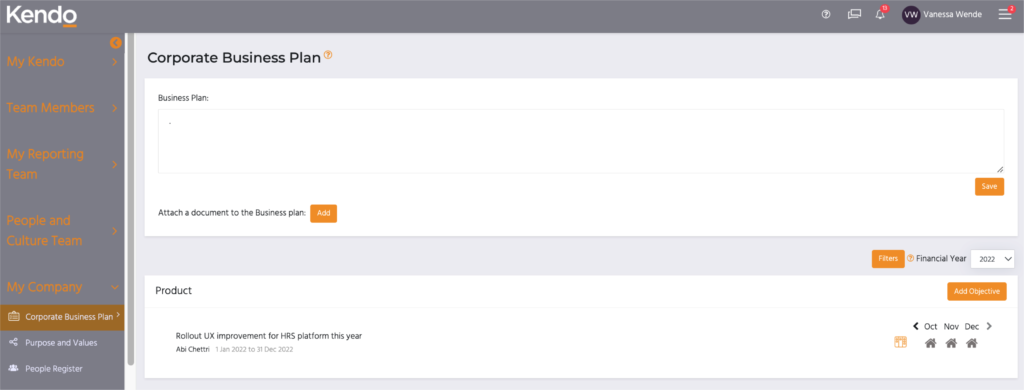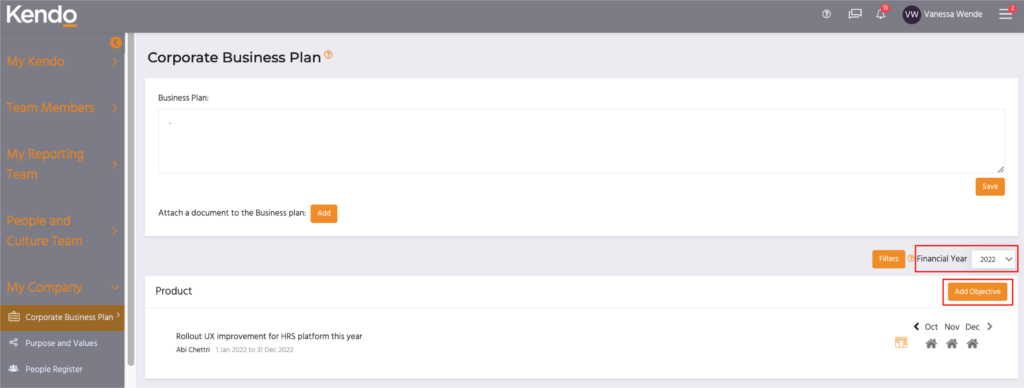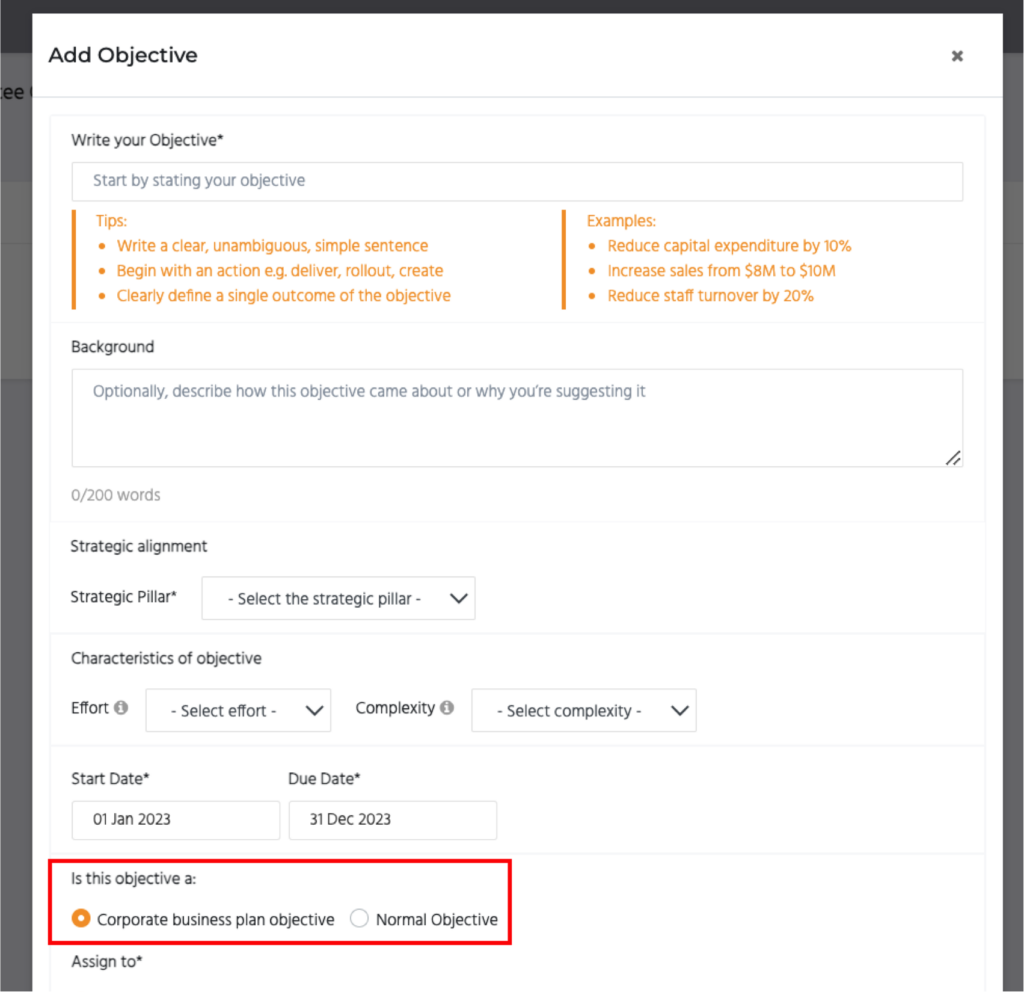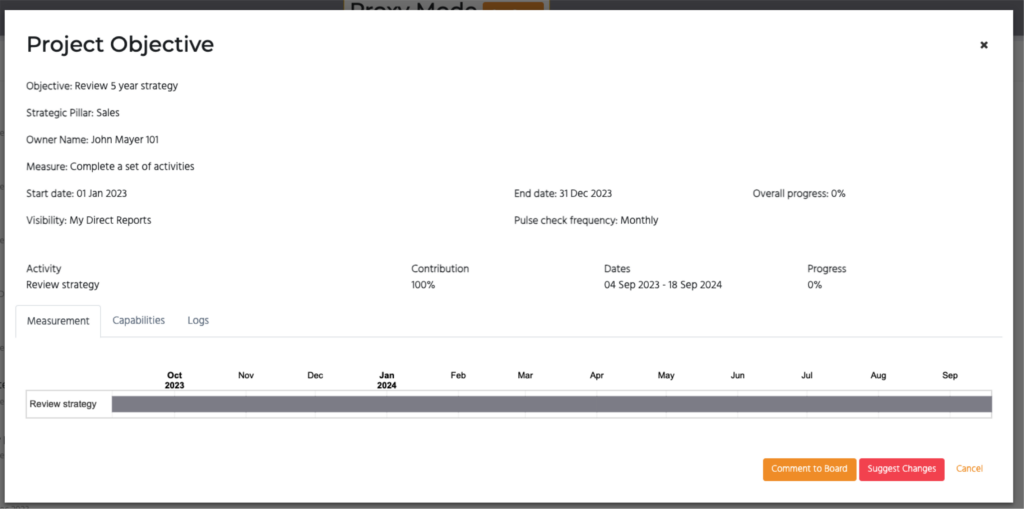Moving from Strategy to Execution
What is the Corporate Business Plan?
- Business success requires a planned approach to identifying key business objectives to achieve the strategy and aligning those to team and individual accountabilities.
- Business strategies are often created without a plan and clear accountability of how they will be delivered, or business wide visibility of progress. A Corporate Business Plan articulates how the strategy will be delivered and measures the success of its execution.
- A new plan is created to define the plan to execute for each year.
- Each plan has a number of strategic pillars.
- The strategic pillars are the high level strategy areas that the business is driving towards. Objectives are aligned to each of these so that it’s clear which objectives are contributing to which area of the plan.
- The executive team generally owns the objectives on the Corporate business plan.
- Once objectives on the plan are agreed, team and individual level objectives can be aligned.
- Regular reporting means risk to non delivery of the plan can be identified well ahead of time.
- Only the CEO (the Corporate Business Plan Owner) can create and approve objectives directly to the corporate business plan
- Other users can be granted view or write permission for the Corporate Business Plan by the Kendo Administrator to view or add objectives directly to the corporate business plan on behalf of the CEO
- People with access to view the corporate business plan (normally the executive team) can ‘add objectives’ via their objectives page on My Kendo but the CEO will determine whether these objectives sit on the corporate business plan or whether they are objectives assigned only to an individual
- Objectives on the corporate business plan will also appear in the individual owners objectives page to ensure each individual is clear on what they have agreed they will deliver and is held accountable to that delivery.
- Once the objectives of the corporate business plan are agreed by the CEO, the plan can be sent to the Board Chair for approval. The Chair and Board members will receive a notification.
- The Chair can review and suggest changes if required. The owner of the objective will be able to view the suggestions and make any changes proposed.
- Once the Chair is happy with the objectives, they can approve the plan in full

Strategic Pillars
- Strategic Pillars must be created before the objectives of the Corporate Business Plan can be added.
- Strategic pillars are a way of categorising the different components of the plan as they align to the business strategy.
- They allow Corporate business plan owners and objective owners to align their objectives into the different areas of the plan so that it’s clear which objectives are contributing to which area of the business plan.
- You can set up as many strategic pillars as makes sense and these can differ from year to year.
- Only the CEO or Kendo Administrator can add Strategic Pillars to the Corporate Business Plan.
Create Strategic Pillars
- To add a strategic pillar, first select the financial year you’d like to add it to, then select “Add Strategic Pillar”

- Name the strategic pillar and save it. To change the order of the pillars select “Reprioritize the order” and drag and drop the pillars in the desired order.

- The Pillar will now appear in the Corporate business plan for that financial year. Business plan and individual objectives can be aligned to the pillar when they are created.
Create the Corporate Business Plan

- The Corporate Business Plan includes a statement that describes the overall strategy of the organisation and objectives that describe how the strategy will be delivered. It allows visibility of how successfully the plan is being executed at any point in time.
- Supporting documents can also be attached that provide further detail
- Objectives on the Corporate Business Plan are the highest level of objective from which other objectives across the business can be defined.
- Corporate Business Plan Objectives can be added directly to the Corporate Business Plan by the CEO. Alternatively, Executives can add objectives from their Objectives page for the CEO to agree
- If the owner is the CEO then they will mark the objective as agreed
Add Objectives directly to the Corporate Business Plan

- Only the CEO is able to add objectives directly to the Corporate Business Plan
- Select the Financial year you’d like to add the objective to. Then Add objective against the relevant Strategic Pillar
- From there, the process is the same as adding any other objective. Further details on how to add an objective can be found in the Setting Smart Objectives guide
- When adding the objective, ‘Corporate Business Plan Objective’ will need to be selected
Add Objectives to the Corporate Business Plan from the Objectives Page

- Corporate Business Plan Objectives can also be created from the My Kendo- Objectives page for Executives who have visibility of the Corporate Business
- When adding the objective, ‘Corporate Business Plan Objective’ will need to be selected.
- Once agreed by the CEO, the objective will then appear both on the Corporate Business Plan as well as on the individual owner’s Objectives page
Board approval
- The CEO can send the Corporate Business Plan to the Board Chair for final agreement. The Board Chair will have the option to approve the entire plan, suggest changes to the CEO for individual objectives, or comment to the Board on an objective if further dialogue with the Board is required

- The CEO will be notified if the Chair suggests changes for an objective and objectives show where a suggestion has been made

- Any comments regarding suggested changes by the Chair will be visible to the CEO and Chair only unless made visible to the other Board members
- Board members can also comment on an objective prior to it’s approval by the Chair – these comments are visible to the Board Chair only
- All comments visible to a user can be viewed on the ‘Comments’ tab of the objective
- If any further objectives are added by the CEO after the Chair has approved the Plan, the Plan can be resent to the Chair for approval. The new objective will be identified as needing Review.

- Once reviewed, the Chair can re-approve the plan
Cascade Corporate Business Plan Objectives
- Once the Corporate Business Plan objective is agreed it can be cascaded. Cascading means delegating the delivery of either part or all of the objective to someone else. You maintain overall responsibility but the accountability for delivering is delegated to someone else.
- You can cascade the whole or part of an objective.
- If you know the milestones to be delivered add them in and you can send the objective to the individual for their agreement.
- Or share it as a draft to allow the owner to map out the detail. Once they’ve competed the details, they can send the objective back for your agreement
- See the Cascading Objectives guide for more information on how to cascade.
- Agreed cascaded objectives will appear below the objective they’ve been cascaded from on the Corporate Business Plan. This helps to see where responsibility for delivery of an objective has been delegated.

- Regular reporting through pulse checks allows leaders to know how the plan is tracking
Report on Corporate Business Plan Progress

- Filter corporate business plan objectives by different criteria to create a view of progress and export to PowerPoint to create a report.

- See how objectives align, up and down, to see dependencies and linked objectives to the plan
- Or select the kanban view to add, update and review progress at the activity level

- The star icon will show you the linked objectives for each objective, including pulse ratings, to get a snap show of how each of the contributing objectives are progressing
- This can be exported to a PowerPoint file
